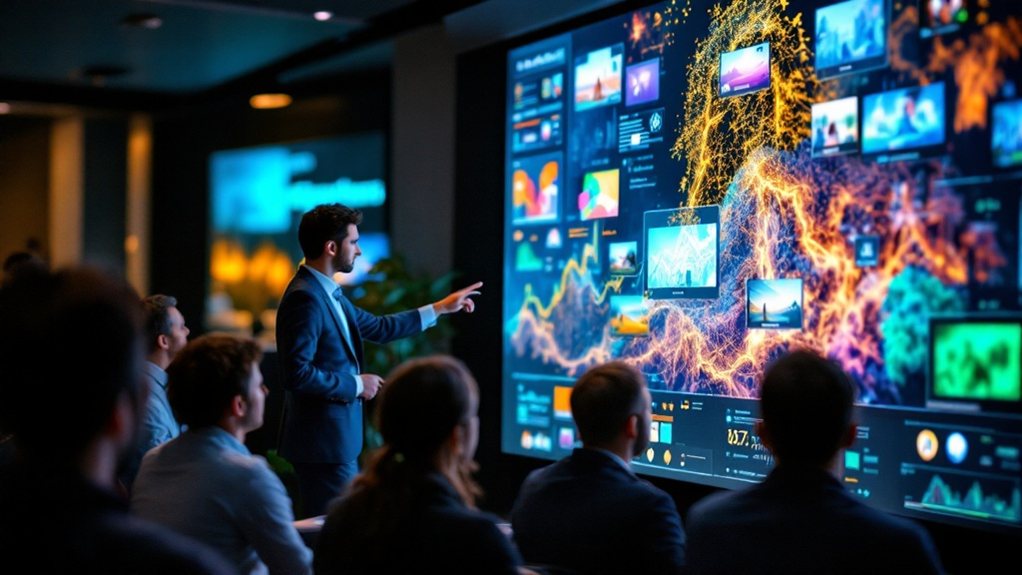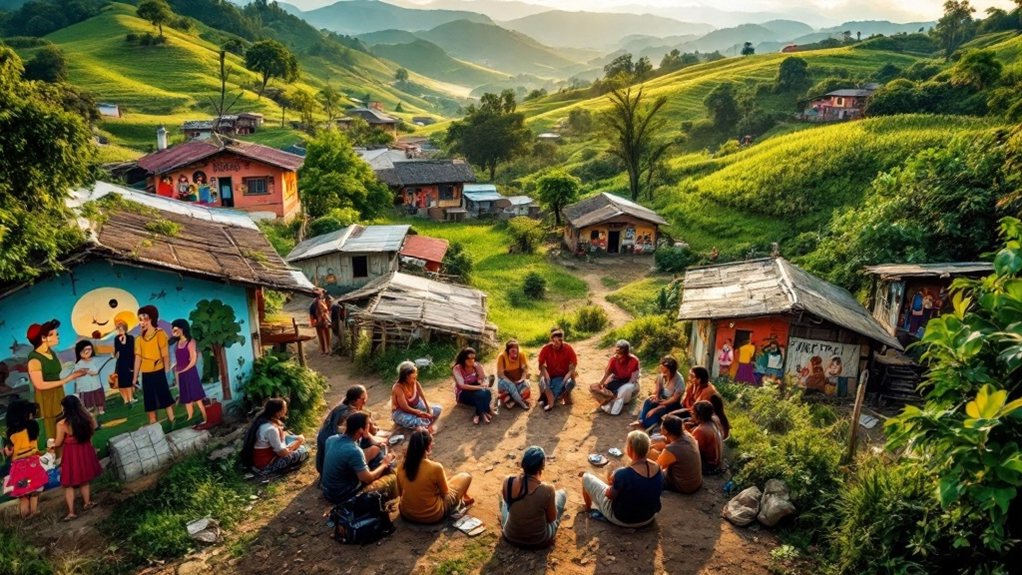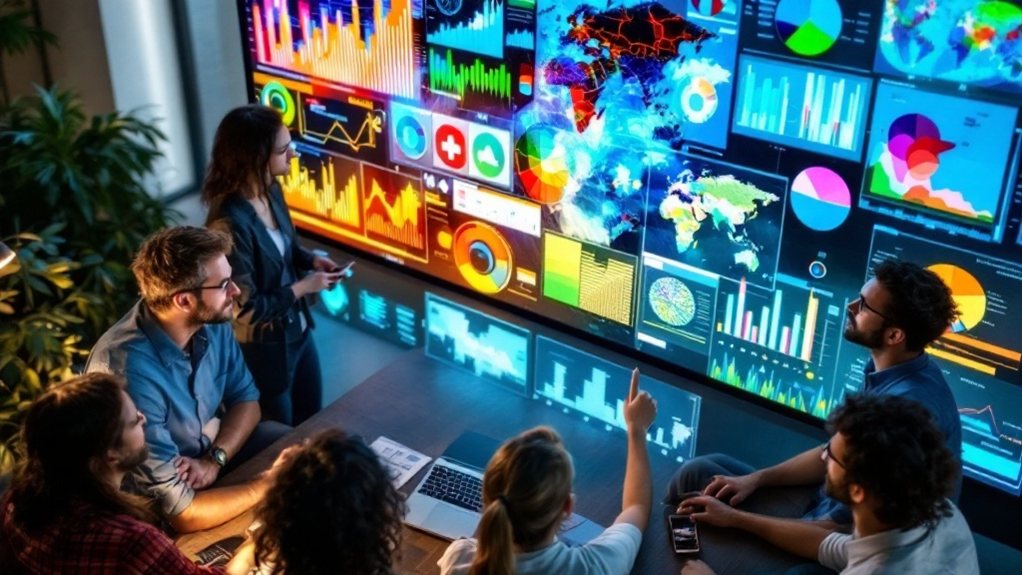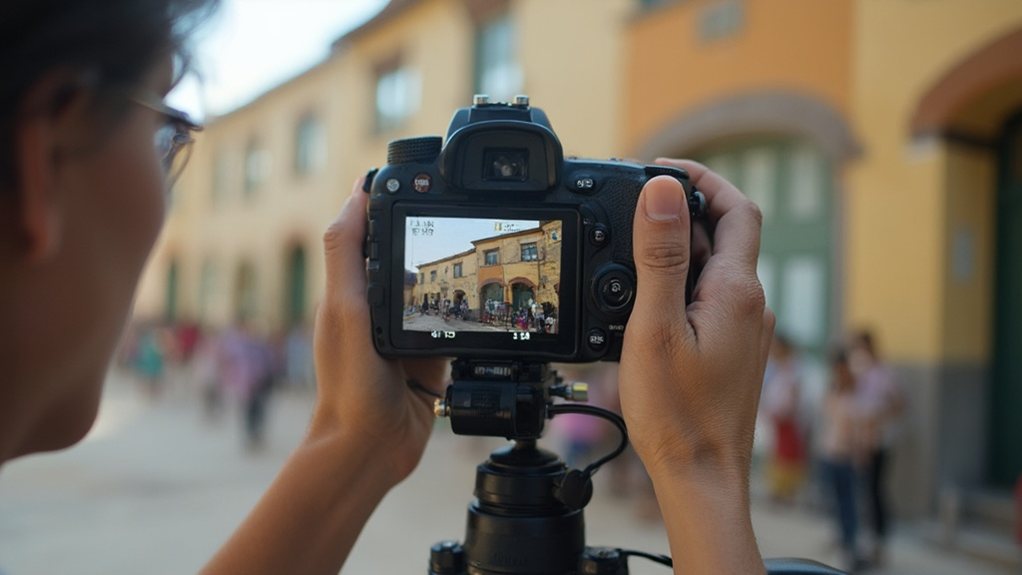Integrate visually striking multimedia that authentically reflects the unique cultural nuances of the local community. Captivating images, engaging videos, and immersive interactive experiences can captivate your audience and foster a stronger connection. Leverage data visualizations and a well-structured narrative to convey complex information in a compelling way. By incorporating these elements, you'll create an engaging case study that resonates deeply with your readers – and there's more to explore.
Enhancing Audience Engagement With Interactive Multimedia

Utilizing a variety of multimedia, from engaging images to captivating videos, can keep your audience thoroughly engaged with your local case studies. Interactive elements like quizzes and polls integrated into videos can boost completion rates by over 50%. Shoppable videos also increase purchase intent by 15%, making them ideal for e-commerce integration. Interactive content can generate up to 5 times more page views than static content, and 88% of marketers plan to allocate more budget to it by 2024. Leveraging these interactive formats can enhance audience understanding, improve retention, and maximize the impact of your local case studies.
Incorporating Local Cultural Elements for Relevance and Interest

Incorporating local cultural elements in multimedia case studies can help you resonate with your target audience. Immersive storytelling that highlights traditional practices, community involvement, and cultural symbolism engages viewers and adds authenticity. By showcasing the vibrant visual representations of local festivals, architecture, and artistic expressions, you can truly capture the essence of the community. Documenting information encountered during daily life can provide compelling content ideas to incorporate into your multimedia case studies.
Resonating With Local Audiences
Resonating with local audiences is crucial when leveraging multimedia, as it allows you to tap into the unique cultural elements that resonate most with your target community. By incorporating authentic visual stories, interactive experiences, and case studies specific to the local context, you can create a stronger emotional connection and sense of relevance. Highlighting cultural festivals, art forms, and community dynamics can further enhance audience engagement. Incorporating local culture is vital for effective and efficient development efforts. Collaborating with local stakeholders ensures your multimedia accurately reflects the community's experiences and heritage. Ultimately, tailoring your content to the unique cultural nuances of your audience can significantly amplify the impact and resonance of your local case studies.
Immersive Cultural Storytelling
When you embrace immersive cultural storytelling, you'll discover how multimedia can transport audiences into the heart of local traditions and experiences. Integrating images and videos engages multiple senses, making stories more captivating. Incorporating cultural elements ensures your narrative resonates deeply, reflecting the audience's identity and heritage. Weave together diverse storylines, like indigenous oral traditions, to enrich your tales. Leverage AR and VR to offer new dimensions of immersion, inviting viewers to explore cultural experiences firsthand. Collaborating with local communities preserves their stories, enhancing educational value. Thoughtful use of multimedia elevates cultural narratives, fostering empathy and understanding across diverse audiences. [Circular structure is a key element of many indigenous oral traditions, creating a sense of continuity and completion.
Leveraging Visual Storytelling to Convey Complex Information

Visuals can simplify complex data, making it easier for your audience to understand. Turning data into visuals can make it easier to comprehend and more compelling. Multimedia elements like videos and interactive maps create immersive experiences that engage viewers. By leveraging data visualizations and an intentional narrative structure, you can effectively convey insights within your local case studies.
Enhancing Comprehension Through Visuals
Visual storytelling is a powerful tool for enhancing comprehension and engaging audiences. By strategically incorporating visuals into your local case studies, you can simplify complex concepts, improve readability, and create an immersive experience for your readers.
Consider these four ways to leverage visuals:
- Contextualization: Use images and videos to provide context, making abstract ideas more tangible.
- Scannable Content: Strategically placed subheadings, bullet points, and pull quotes enhance readability.
- Multimedia Variety: Incorporate diverse visuals, such as infographics and interactive maps, to maintain audience interest.
- Emotional Connection: Visuals that evoke emotions can help your message resonate more deeply.
Visuals have the power to evoke emotions and establish a connection between writer and reader. Embrace the power of visual storytelling to create local case studies that captivate and educate your audience.
Conveying Insights With Data Visualization
As you've seen, visuals play a pivotal role in enhancing comprehension and engagement. Data visualization is a powerful tool that transforms complex data into meaningful insights. By representing data graphically, you can identify patterns, uncover trends, and convey stories that resonate with your audience. Effective data visualizations further enable deeper exploration, facilitating informed decision-making. Visual storytelling techniques like using emotive imagery and presenting evidence visually can make your case studies more compelling. To maximize the impact, ensure your visuals are clear, concise, and focused on the key data points. Leveraging the right multimedia elements can elevate your local case studies, making the information more accessible and impactful.
Immersive Experiences With Multimedia
Although visuals play a vital role in conveying complex information, multimedia storytelling takes it a step further. By leveraging an immersive experience, you can captivate your audience and enhance their understanding. Multimedia stories provide new opportunities for telling stories and engaging audiences. Consider these strategies:
- Storyboard your narrative to outline the flow and structure.
- Encourage audience engagement through interactive elements like quizzes and discussions.
- Evoke emotions and empathy by using powerful imagery and sound.
- Arrange your story elements into a cohesive narrative flow using story mapping.
Ultimately, a well-crafted multimedia experience can transform how your audience perceives and retains complex information, leaving a lasting impression.
Integrating Data Visualization to Support Insights
Data visualization can be a powerful tool in local case studies, enabling you to uncover insights and communicate findings more effectively. By incorporating advanced techniques like interactive dashboards and geospatial mapping, you can identify trends, patterns, and correlations within your data that may not be immediately apparent. Visualizing real-time data can further enhance the immediacy and relevance of your case study insights. Additionally, tailoring the visualizations to the specific needs of your community can make your findings more impactful. Integrating data visualization with multimedia elements, such as images and videos, can create a more compelling and engaging case study that resonates with your local audience. Leveraging innovative chart types beyond traditional bar and line graphs can also help to better contextualize and communicate the insights derived from your local case study.
Ensuring Accessibility Through Multimodal Presentation
Ensuring accessibility through multimodal presentation is crucial for reaching diverse audiences effectively. By incorporating multiple forms of media, you can cater to various learning styles and accommodate users with different needs. Consider the following strategies:
- Utilize captioning and audio descriptions to support hearing and visually impaired individuals.
- Employ high-contrast visuals and logical slide structures to enhance readability.
- Incorporate interactive elements like quizzes and polls to foster audience engagement.
- Adapt content for cultural sensitivity and provide multilingual options when possible.
- Multimodal presentations can simplify communication by enhancing the interaction between the presenter and the audience.
Employing these principles of universal design for learning will ensure your local case study presentations are inclusive and impactful for all participants.
Selecting Appropriate Platforms for Multimedia Creation
With accessibility addressed, the next step is choosing the right multimedia platforms to create your local case studies. Look for platforms like Foleon that offer interactivity, seamless multimedia integration, and SEO optimization. For greater efficiency and content quality, consider AI-driven tools like AIContentPad, which can streamline creation and enhance personalization. Ensure your chosen platform aligns with your brand's visual identity through custom themes and templates. Finally, prioritize platforms that integrate smoothly with your existing workflows and CRM systems to automate processes. By selecting the right multimedia tools, you can elevate your local case studies and deliver an engaging, impactful experience for your audience.
Crafting a Well-Structured Narrative in Multimedia Stories
Crafting a compelling narrative is key to captivating your audience. Structure your story with intention, guiding viewers through a cohesive flow of information. Leverage multimedia elements strategically to reinforce your message and hold their attention.
Compelling Story Structure
When crafting a well-structured narrative in multimedia stories, you'll want to start with a compelling introduction that immediately grabs the audience's attention. This can be achieved by:
- Crafting an engaging initial hook using captivating visuals or compelling statistics.
- Establishing clear relevance by communicating why the case study matters to the local audience.
- Providing contextual setup through a mix of text, images, and video to make the case study relatable.
- Tailoring multimedia content to work seamlessly across different devices and platforms.
Maintain audience interest by balancing multimedia elements, organizing them in a logical sequence, and ensuring consistency in style and tone. Leverage interactive options, real-time feedback, and immersive techniques to further engage your audience.
Cohesive Narrative Flow
A cohesive narrative flow is the backbone of a well-structured multimedia story. Craft a strong core message that resonates across all formats. Ensure content adaptability to various platforms, leveraging each medium's unique features. Incorporate engagement elements like polls and user-generated content to boost audience participation. Maintain consistent branding to build trust, and follow a clear story arc to enhance emotional connection. Reinforce the narrative through visual consistency, pacing, and seamless transitions. Leverage the right multimedia formats strategically, with a well-planned content calendar that preserves story continuity. By weaving these elements together, you'll create a captivating, cohesive multimedia experience that resonates with your local audience.
Guiding Audience Attention
Effective multimedia storytelling hinges on guiding your audience's attention through strategic visual techniques. Evoking emotional engagement with impactful imagery and videos can foster deeper connections. Leveraging the brain's efficient visual processing, data visualizations and interactive elements enhance comprehension and participation. Contextual storytelling using diverse multimedia provides essential context, enriching the narrative experience. To balance clarity and impact, ensure your multimedia supports, rather than overwhelms, the core message. Consider your audience, provide simple navigation, and tailor the variety of formats to maintain engagement.
- Emotional Engagement
- Visual Processing
- Contextual Storytelling
- Balanced Multimedia
Maintaining Viewer Interest With a Variety of Media
Maintaining viewer interest is crucial when creating compelling multimedia content. Incorporate a variety of visuals, sounds, and pacing techniques to keep your audience engaged. Use graphics, animations, and dynamic backgrounds to simplify complex information. Ensure high-quality audio with strategic sound effects and balanced dialogue. Experiment with scene length variations, fast cuts, and transition effects to establish a rhythmic flow. By mastering these multimedia elements, you can capture and sustain your viewers' attention throughout your local case study.
| Visuals | Sound | Pacing |
|---|---|---|
| Graphics and Animations | Background Music | Scene Length Variations |
| Text Overlays and Captions | Sound Effects | Pacing Techniques |
| Dynamic Backgrounds | Audio Quality | Build-and-Release Technique |
Balancing Conciseness and Depth in Multimedia Content
When creating multimedia content for your local case study, you'll need to strike a careful balance between conciseness and depth. Focus on highlighting the key points using visuals, keeping accompanying text brief yet informative.
To achieve this balance:
- Prioritize the most critical information and use multimedia to reinforce it.
- Avoid redundancy by eliminating any text or visuals that don't add significant value.
- Employ visuals to simplify complex concepts and make data more engaging.
- Organize your multimedia elements to flow logically and maintain viewer interest.
Fostering Community Engagement Through Interactive Multimedia
Multimedia can be a powerful tool for fostering vibrant community engagement. Utilize online platforms to conduct polls during virtual events, fostering interactive discussions. Incorporate visual data into interactive infographics to engage communities by explaining complex issues visually. Stream events via platforms like Zoom to allow real-time engagement through Q&A sessions. Implement game-like elements, such as rewards for active participation, to encourage community involvement. Use social media for sharing updates and hosting community discussions to keep communities informed. These interactive multimedia approaches can help build stronger connections and amplify community voices.
